BCBC Conference Review and Spring Newsletter 2019
Message from the New BCBC Chairman, Laurence Loxam
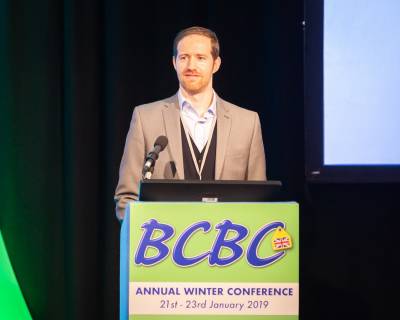
2020 – Focusing on succession to build a sustainable future
It is a great honour and privilege to have been elected Chairman of the British Cattle Breeders Club and I am excited to be leading the club into a new decade. As Chairman, I will guide and mentor the club through 2019 and on to the prestigious and world-renowned conference in 2020.
I should like to begin by thanking and paying tribute to our outgoing Chairperson, Anya Westland. My sincere congratulations to Anya and her committee on a job well done. I am also delighted to offer a warm welcome to new committee members Amy Hughes, Ruari Martin, Melissa Roberts and Fern Pearston who have joined the team. We have already started planning for this year’s events, culminating in the annual conference in 2020. Our aim for the conference is to embrace the ‘sea change’ our industry is facing, and in this we are not alone. Climate change affects us all, but through succession, sustainability and leadership we can all play our part as we enter a new decade.
I first attended the BCBC conference in 2010 and it was then that we all looked towards 2020 as our next key milestone and planned our strategies to take us there. We should all take time to reflect on the last ten years and to also start planning the next five and beyond. Back in 2010 we did not know that we would be about to embark on a new journey, outside of the EU, and so with Brexit here we have the opportunity to focus positive attention on breeding beef and dairy cattle that will suit our systems, meet consumer demands and fulfil market require ments.
Continuing to evolve while strengthening co-operation will be vitally important in light of increasing pressure on the livestock industry from recent negative campaigns via social media and other channels. As we look to the future, it is imperative that we continue to shine the best possible light on the cattle breeding industry. Ours is an industry that not only strives for high levels of animal health, welfare and production efficiency, but also aims to deliver high quality and nutritious animal protein products. In this spirit, I challenge each of you to show that we are the driving force behind a more sustainable agriculture sector, as we step towards a future in which breeding for more efficient animals takes ever more precedence.
We are proud that farmers, researchers, students and all manner of industry stakeholders continue to support the BCBC. Through the work of our club, our members can engage in lively discussions and embrace the opportunity to stay abreast of the latest developments in research, technology and best farming practices. Our members are central to helping us achieve our core mission of enhancing the future of UK cattle breeding and genetics.
The broad cross-section of conference delegates provides excellent networking opportunities. Equally important is the social element of the Club; there is great camaraderie among members and a real sense of belonging. The BCBC always welcomes newcomers and gives everyone an oppor tunity to get involved. I would urge anyone with an interest in the UK cattle industry to join us – the annual Club fee is only £35 and offers discounts for our annual two-and-a-half day conference, access to the conference reports, talking slides, farm walks and a quarterly magazine – offering great value for money.
The club’s challenge; Delivering succession, sustainability, healthy planet and healthy people.
Conference Review - Beef Day
Minette Batters - Challenges & Opportunities to Promote the UK Livestock Sector
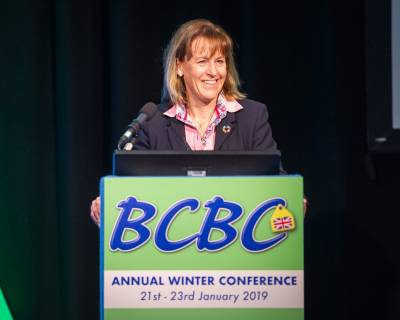
NFU President Minette Batters opened the 2019 BCBC Conference looking at what the future holds for UK agriculture, in light of Brexit and the challenges ahead. She explained that The Agriculture Bill, the root of the UK’s agricultural policy after Brexit, is a landmark piece of legislation, and it must and should have lasting legacy.
Minette feels that the Bill needs to be committed to agriculture “It must have food production on the face of the bill. It must be an agricultural bill for agricultural purposes,” she stressed. As well as having food production on the bill she also feels that both food standards and a multi-annual budget need to be enshrined in the legislation.
Minette also spoke about how the Livestock Information Service (LIS) has the potential to transform the sector through greater transparency and data sharing. The new service, which is to be launched from the end of this year, will provide the foundation for some of the best farm to fork traceability in the world by using electronic IDs to collect animals’ medical information and track their movements across the country.
She also highlighted that the Agricultural Bill has a huge part to play in improving how data is used in order to increase productivity and transparency in the supply chain. “Britain has the potential to be the number one supplier of choice globally. If we are to build upon our reputation of producing some of the best meat in the world, we need to be on the front foot when it comes to quality, accurate, easy-to-use data.
“By putting food safety, animal health and welfare and environmental enhancement at its core, the Livestock Information Service can help build productivity, drive a progressive UK livestock industry after we leave the EU and underpin the quality of Brand Britain.
“Looking more widely at the farming industry as a whole, the Agriculture Bill provides an opportunity to change the way we collect and use information to enhance British food production, benefiting farmers, government, the wider supply chain and, most of all, the British public,” she said.
Robert Drysdale - Taking dairy beef from by-product to an ethical and sustainable resource
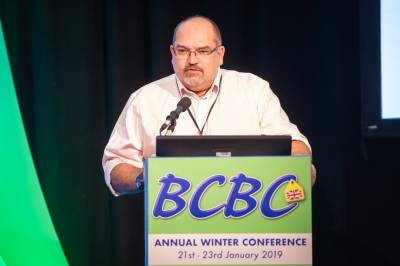
Vet and farmer Robert Drysdale spoke to the BCBC 19 Conference about how his Nuffield Scholarship to look at dairy beef has led to the development of an integrated beef business that runs from conception to customer.
Robert spoke about the challenge to the British beef industry being not so much about feeding a world population of nine billion people, as we could do that now if we eliminated the level of food waste we have in the world. It is more about the fact that by 2050 there will be 4.9 billion middle class people in the world and the changes in eating habits that will bring. He feels that we need to attract these new consumers to our products.
At the same time, he continued, we also have the rise of the flexitarians, those people who want to eat less beef, but better beef. These are the people British beef need to keep eating its product. The industry is also having its sustainability and environmental credentials, its traceability and assurance questioned.
“Brand management is about taking some - thing and making it positive in the eyes of the consumer,” continued Robert. “For beef that means consumer perception of the product, eating quality, consistency of product and crucially transparency of the whole production system.
“We need to give consumers clarity about our industry and provide them with a consistently excellent product in order to keep them on board with our brand,” he says.
As a result of his Nuffield Scholarship Robert has taken lessons from the integrated poultry and pig industry, and from beef businesses abroad to develop a dairy beef business, StraightLine Beef. StraightLine beef takes about 4,500 head of cattle a year from conception to customer with everything controlled for that animal along the way, ensuring a consistent product, full measurability, traceability and an open and transparent farm.
Robert has learnt from other industries and adopted new technology to encourage great growth rates and ensure that StraightLine products have a consistent quality, high tenderness and great flavour.
“Crucially, the customer is the starting point of the whole process. We work with four or five different customers and pick our cattle for their different requirements. It means every animal that leaves the farm goes to a customer that
really wants it,” Robert explained.
Dr Robert Banks - Strategies for ensuring breeds’ viability in the genomics era; beef breeding as an information business
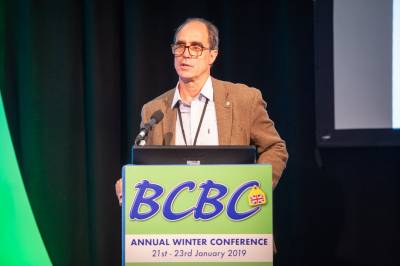
Dr Robert Banks, Director of Animal Genetics Breeding Unit, New England University, Australia, spoke about the need to reward those farmers creating a reference population for genomic breeding.
“For breed societies to make use of genomics they are going to need a reference population,” he explained. “This means breed societies are going to have to collect data for the traits that matter in sufficient numbers of animals that have DNA information available as well. This is doable for most breed societies but the challenge for small societies is to ensure they are getting the data on the right traits.
“Genomics allows us to evaluate (get their genetic merit calculated) our cattle without doing any of the recording, but somewhere along the line breed societies are going to have to ensure that those that are collecting the data are getting sufficiently rewarded, in order for this process to work,” he added.
“In many ways genomics makes it easier for a breed to grow. As long as someone has done the recording, creating a reference population, many others can use this information,” he concluded.
Matthew Murphy - Successfully using AI in a 100 cow suckler herd
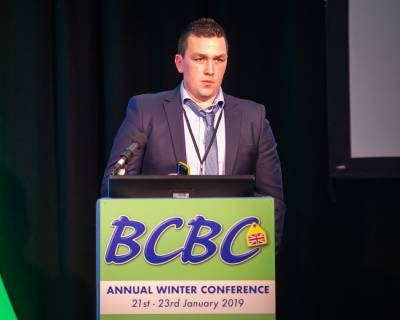
Matthew Murphy, farm manager at Newford Demonstration Farm, Athenry, Co Galway, spoke about using AI on a 100 cow suckler herd at the Beef Day at the BCBC19 Conference.
Newford Farm was set up in 2015 to demonstrate to farmers the technical efficiencies that could be made within their own farm gates. But it is also a commercial farm that needs to make a profit, Matthew was keen to stress. The farm has a 100 cow suckler herd, run with one labour unit (apart from assistance from an agricultural student during calving season). There are over 70 paddocks across the three farms that make up on the demo unit and there is a good track network on the farm.
In 2018 the farm’s calving interval stood at 362 days (average for Ireland is 402 days) and weaning weight has risen in the herd from 262Kg in 2015 to 312.5Kg in 2018.
“By choosing the correct sires via AI we can make our calving easier,” explained Matthew. “In 2018 the herd had 86 normal calvings, 12 needed some assistance, nine were classed as difficult but no cattle needed vet intervention.
“We use AI on the suckler herd because it gives us access to a wider pool of genetics, not just the three or four bulls we might run with the herd,” he added. “Our cows come from dairy herds so have good maternal traits, they’re milky and fertile, so via AI we can concentrate on terminal sires to add carcass conformation or kgs produced. AI also reduces the risk of an infertile bull having a large effect on the herd.” There is a 10 week breeding season at Newford Farm, with all cattle going to AI. In 2018 60 cows became pregnant to the first service, 20 held to second service and 11 to the third service. There were four sets of twins.
“Farmers ask us about the mechanics of getting the suckler cows in every day during the breeding season, but as we rotational graze the cows automatically they think we’re moving them to a new piece of grass, and are happy to follow me,” said Matthew.
“I do all the inseminating and we AI once a day, at noon, removing the need to move them twice a day. This means that I AI anything I see the night before or that morning that day and leave anything I see bulling that afternoon to midday the next day. All of last season I only had to repeat 18 straws on cattle using this method, and at about €10 a straw the economics stack up,” he added.
The Dairy Day
Christine Middlemiss - Enhancing our UK USP; a CVO perspective on animal health and welfare
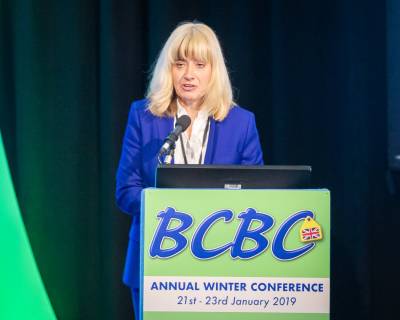
Christine Middlemiss explained that part of herrole as UK Chief Vet is to represent our animals’ health and welfare globally. She stressed that having international engagement and influence is crucial in terms of trade requirements and protocols, and when building relationships with other countries’ Chief Vets so they understand what our processes and procedures are.
“This is an industry-wide role and only works because government, vets, levy boards and farmers work in partnership, with consistent messages,” she said. “What goes on at farm, or even at cow level, can really matter to international trade. We work hard with those we export to, or hope to export to, so that they understand what has happened and what is being done. Because of the huge number of missions and visits over the year, international partners understand our systems and importantly we know what they are looking for in products we want to place in their markets, she explained.
“For example the Chinese are very focused on food safety due to their experiences, while the Japanese are very trusting of their officials in that respect. However, food quality, throughout the food chain, is very much important to
them,” Christine added.
She went on to explain that it is really important that the UK evidence its health and welfare status, demonstrating how it knows what its status is and how we go through the process to share that information. The UK is respected globally because it publishes its risk assessments, reviews and reports.
“We are very transparent about what we do and that helps officials and scientists in other countries see that we are using the best science and evidence to make our animal health and welfare decisions,” Christine said.
She added that the UK also needs to think what future animal health and welfare look like in order to support trade. Our animal health and welfare policy makes us a credible trading partner, enhances the productivity of UK agriculture and builds a brand for the UK.
Andrew Le Gallais - Adding Value: the Power of Pedigree

Andrew Le Gallais, dairy farmer and Chairman of the Jersey Milk Marketing Board, spoke to the Conference about developing the Jersey brand.
With just 14 dairy farms on the island by the end of the year and with high production costs both at farm and processing level, Andrew explained the importance of the close relationship between the Jersey breed society and the processor, Jersey Dairy. The two bodies, that today even share the same site, recognised the importance of building the Jersey brand to slowly create an export market in order to facilitate controlled growth of milk supply and a dilution of fixed costs at farm and processor level.
The Jersey milk marketing Board micromanages the milk supply on the island to ensure that what is being produced on farm matches consumer requirements. About 10% of milk value is derived from bonuses in line with market requirements, and Andrew believes that genetics has an important part to play in the brand’s success to date.
The pedigree of the Jersey cow underpins the integrity of the entire supply chain. The board firmly believe in the formula of ‘provenance and quality = consumer trust’. In terms of ‘provenance’ it stipulates that all milk from every farm must derive from cows registered in the Jersey herd book. ‘Quality’ is demonstrated via a constant stream of evidence to consumers; all members must be officially milk recorded each month, they must take part in regular stock disease testing (organised by the breed society), and all cows must graze between April and September. Together these elements provide the ‘consumer trust’ that is key to the brand’s success in its increasing UK and Far East export markets.
In terms of breeding, the society has a herd book which dates back some 150 years and, while forward thinking, is keen to protect the breed’s integrity. When the change in laws allowed the importation of international semen in 2008, the breed society declared that only bulls with at least seven generations pure (and no records of any other breed in their history) would be able to be registered. Over the last 10 years, the effect of using this semen has been estimated by Maurice Bichard as supporting a 20 % increase in milk yields, and improvement in virtually all measurable traits. The plan for the next ten years is currently being agreed.
Andrew argued that the relationship between building the brand and the future success of the breed is inextricably intertwined – “Branding starts on the farm,” he said. Adding value to the dairy products produced on farm, gives producers the resources and drive to farm in a way that concentrates on further developing milk quality and environmental aspects of their products as well as health and welfare – which in turn enhances the Jersey breed provenance and subsequent value of the brand. If the island cannot continue to build the value of the brand then farmers will be forced to concentrate on producing more milk through higher yields to reduce costs and focus less on producing a product that has the provenance and quality that makes it internationally appealing.
Bryce Cunningham - Changing dairy, our attempt so far
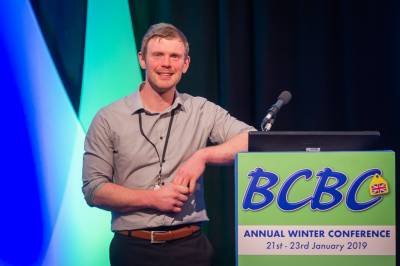
Connecting to his local community and providing a product they want has been key to the success of Ayrshire dairy farmer Bryce Cunningham’s business success. He took delegates at the BCBC Conference through the development of the farm and plans for the future.
After losing his grandfather and father in quick succession, a milk price collapse, the loss of his milk buyer and his bank pulling the finance, Bryce, didn’t give up. Instead, he took the opportunity to rethink his business and has now built a successful organic dairy unit, supplying the local community and the speciality coffee industry in Edinburgh and Glasgow.
“The milk price collapse led to a loss of £100,000 in the first year after my father’s death and the bank pulling the finance meant I had to sell over 80 cows (taking herd numbers down from 150 to 66) and sell some land to pay off debts,” explained Bryce. “But it gave me a chance to really think about the strengths of the business and how to develop it for the future.”
It was after appearing in the media on dairy farming issues that Bryce began to be contacted by consumers, sympathetic with the plight of local farmers and keen to find out how to buy local produce.
“I became aware that there was a market place for local milk for local consumers who wanted full traceability on the product. They were also after a product that was as natural as possible. As a result we began to sell our milk direct to consumers, under the Mossgiel label and began the process of organic conversion,” he explained.
Bryce used a simple pasteurising process in order to keep the milk as close to its natural, individual taste as possible. The business developed and they now supply milk to 500 doorsteps around Ayrshire and have two milk vending machines. They have taken on milk from two other organic units in the area and also supply two speciality cheese makers in Scotland.
“We have been overwhelmed with support from the local community, driven by a desire to support local farms and recently driven by the plastic-free movement. All our milk goes out in glass bottles or reusable containers. We love to shout about the grass-fed aspect of organic farming and the connection we have to our customer through social media is great,” Bryce said
The biggest single customer for Mossgiel milk is the speciality coffee market in Glasgow and Edinburgh, which Bryce has developed over the past few years and now supplies with 10,000 litres a week. “We work very closely with clients to develop the quality taste and provenance of the unique milk they are looking for. We keep each farm’s milk separately to develop an individual taste that links with what our coffee customers are after,” explained Bryce.
Now a fully organic unit Mossgiel has recently committed to becoming the UK’s first plastic-free farm and is trialling a bio degradable silage wrap made from langoustine shells. As part of the drive to provide consumers with a unique story Bryce is also trialling a ‘calf at foot dairy’ approach. Calves stay with mothers 24 hours a day for the first month, then the calves are with their mothers just for the day for the next month and in the third month calves are with their mothers for four hours a day.
Dairy Workshop
Managing Inbreeding
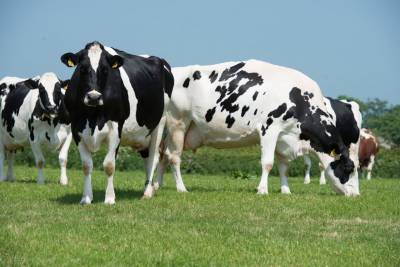
Delegates received an update from Professor Mike Coffey (Egenes-SRUC), Marco Winters and Fern Pearston (AHDB Dairy) on the topic of inbreeding in the UK dairy herd, covering national trends, tools available to manage inbreeding and latest research.
The workshop began with a review of the current inbreeding trends of the major UK dairy breeds. All but two breeds have been steadily increasing in inbreeding over the years, with Holstein pedigree females the highest on average at around 5% in the most recent year of birth. Although Holsteins are continuing to increase, the rate of increase has slowed since the mid-90s which is a positive trend. By keeping the rate of inbreeding to a minimum, natural selection removes harmful recessives over generations, ensuring favourable genetic gains and healthy animals.
Next, the results and conclusion of an SRUC study investigating the effect of inbreeding on animal performance were covered. The analysis showed that the effect of inbreeding was non-linear with inbreeding depression having a negligible effect on the example PTA (milk kg) when below 5%. The study concluded that the effect on individual PTAs were similar to other country findings and relating this back to the UK economic index, for every 1% increase in inbreeding above 5% we would expect approximately 10 £PLI to be lost in the resulting progeny due to inbreeding depression.
The final discussion covered current and new tools to help monitor and manage inbreeding. Current tools and methods available from AHDB discussed were;
- Herd Genetic Report to monitor herd inbreeding
- Inbreeding Checker to manage short-term inbreeding in the next generation
- Using a variety of bloodlines to manage long-term inbreeding
UK genomic inbreeding figures will be available for genotyped animals from AHDB Dairy in the coming year. This will give a more accurate estimate of how inbred an animal is by measuring whether two copies of a “gene” are inherited as opposed to pedigree inbreeding, which is a probability that this will happen. Once UK genomic inbreeding figures are available to the UK dairy industry these will be incorporated into the AHDB Inbreeding Checker to manage future matings, along with the other proposed updates;
- Rather than control level of inbreeding by measuring against an absolute value (6.25%), the tool will be used to control rate of inbreeding change. This will give a positive or negative value. Unsafe matings will be indicated as those with an increase in inbreeding above a threshold, currently set a +1% increase.
- To control long term inbreeding, an additional step will be added to the tool once potential sires have been selected to use on the females. The tool will indicate if these bulls are closely related, encouraging the user to consider a variety of bloodlines in their choice of mating sires.
- Functional updates fed back to the AHDB Animal Genetics team from farmers and regular users of the tool will also be incorporated.
If you would like to sign up for a Herd Genetic Report please contact Dairy.Breeding.Evaluations@ahdb.org.uk with your milk recording number, trading name and address. Please note you must be fully milk recording with NMR, CIS, Dale Farm or QMMS to qualify for a Herd Genetic Report.
Shout about the Sire
AHDB announce campaign
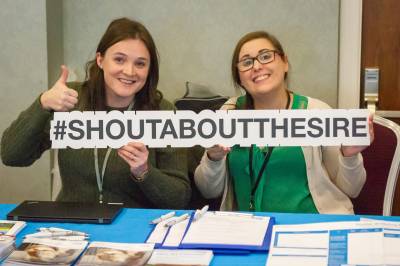
Delegates at the 2019 BCBC Conference were encouraged to ‘Shout about the sire’ an AHDB campaign to encourage the registration of sires on cattle passports.
“Only 23 per cent of sires are currently registered on passports. This means farmers need to start recording to help drive the industry forward and improve profitability,” said Alex Brown, Breeding Project Manager at AHDB. “Increasing the levels of sire recording on passports would drive genetic improvements by increasing the proportion of data that could be utilised in commercially relevant evaluations.”
‘Shout about the sire’ campaign follows the development of the new AHDB National Beef Evaluations, which deliver Estimated Breeding Values (EBVs) linked to traits that commercial farmers get paid for, such as carcase quality and speed of finishing.
Funded by AHDB Beef & Lamb and Hybu Cig Cymru – Meat Promotion Wales, the new EBVs are not only a big step forward for suckler-bred animals, but are also relevant to beef on dairy sires, with some bulls having the potential to produce a calf which will be much more profitable when put into the beef supply chain.
Amy Fawcett, AHDB Knowledge Exchange Manager said: “EBVs give farmers a good idea of the genetic potential that a bull will pass on to his calves, and should always be taken into consideration when purchasing stock bulls or choosing AI sires. Although terminal traits such as growth rate and muscle depth are a step in the right direction to producing profitable carcases, they are an indirect and therefore imperfect measure of carcase performance.”
The latest EBVs available to producers have been calculated using data from BCMS, abattoirs and breed societies, with 40 per cent of the national kill and more than two million carcase records for both purebred and crossbred animals used.
“It was disappointing to find out that there are an additional two million abattoir records that cannot be used to generate EBVs, as the sire details of the finished animal were not recorded when farmers registered their calves. For a farmer, this means they are missing out on having access to EBVs for traits that they could potentially make money from,” explained Amy.
The new campaign aims to drive the industry forward and help to generate the data that can help farmers make the best decisions about their herd-breeding strategy.
“We’re going to be working closely with industry bodies including breed societies, semen companies and vets to encourage beef and dairy farmers to get recording and shout about their sires. The more data collected, the more accurate the EBVs will be,” said Amy.
To make it easier for farmers, AHDB Beef & Lamb has produced a Suckler Breeding Plan to help farmers record sires used on groups of animals if access to computer software is not available. This can be found
at http://beefandlamb.ahdb.org.uk/returns/breeding
Mainline sponsors
Zoetis announce new partnership

The 2019 British Cattle Breeders’ conference held in Telford in January saw the announcement of a new partnership between the genomic test offerings of NMR and Zoetis.
This partnership will utilise the strengths of both companies to bring an enhanced experience to vets and farmers alike and will allow the two companies to work together to help grow the accessibility of genomic testing to UK dairy farmers.
CLARIFIDE® gives strategic breeding options with the added value of a bespoke consultancy package through trained vets. It allows testing of animals from six breeds; Holstein, British Friesian, Guernsey, Jersey, Ayrshire and Brown Swiss.
NMR will continue to offer its GeneTracker genomics testing service which will now be powered by CLARIFIDE, allowing access to additional breeds and male testing which were not previously available.
With just one simple test and up to 70% reliability, CLARIFIDE gives a prediction on;
- £PLI
- Health and Fitness
- Production and Management
- Type and Composites
- Milk Protein Components
- Parentage and Inbreeding
This is compared to just 15-30% reliability when selecting heifers using Parent Averages or less than 1% if selecting by eye. CLARIFIDE results will be reported via Zoetis’ new online software package, SearchPoint, bringing enhanced accessibility and functionality and enabling better use of genomic data.
Zoetis Genomics Business Manager Phil Cullinan said: “The partnership means farmers will have greater access to genomic testing through CLARIFIDE. This means producers can not only speed up genetic progress, but reduce their heifer rearing costs by reliably predicting a heifer’s ability earlier, so they can keep and manage the animals that fit the farm’s future goals.”
NMR’s genomics manager, Richard Miller, added: “CLARIFIDE and GeneTracker Powered By CLARIFIDE users will benefit from a more integrated and comprehensive service. Both services will have automatic access to AHDB data and offer accurate reporting and results analysis options through the InGENEious and SearchPoint platforms. This will help producers and their advisers maximise the benefit of genomic data in their herds.” For more information visit www.clarifide.co.uk or the NMR website.